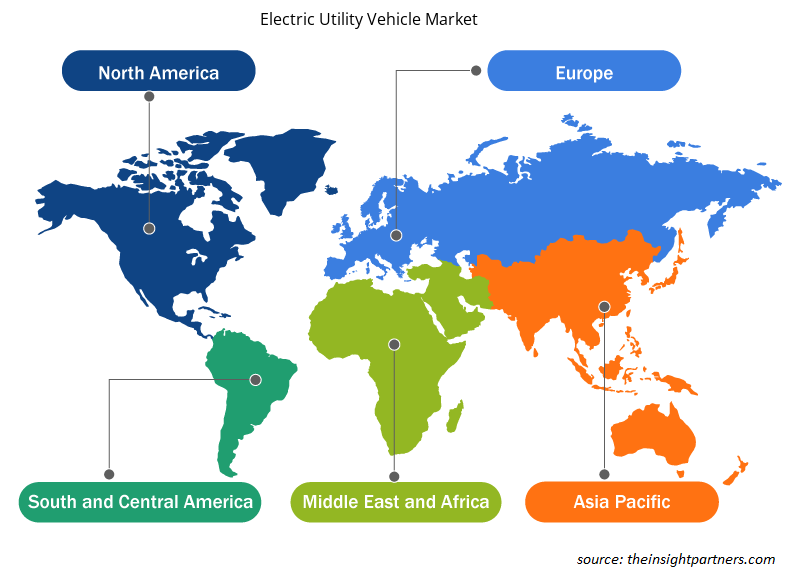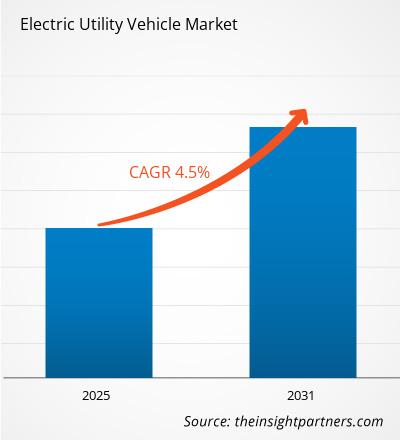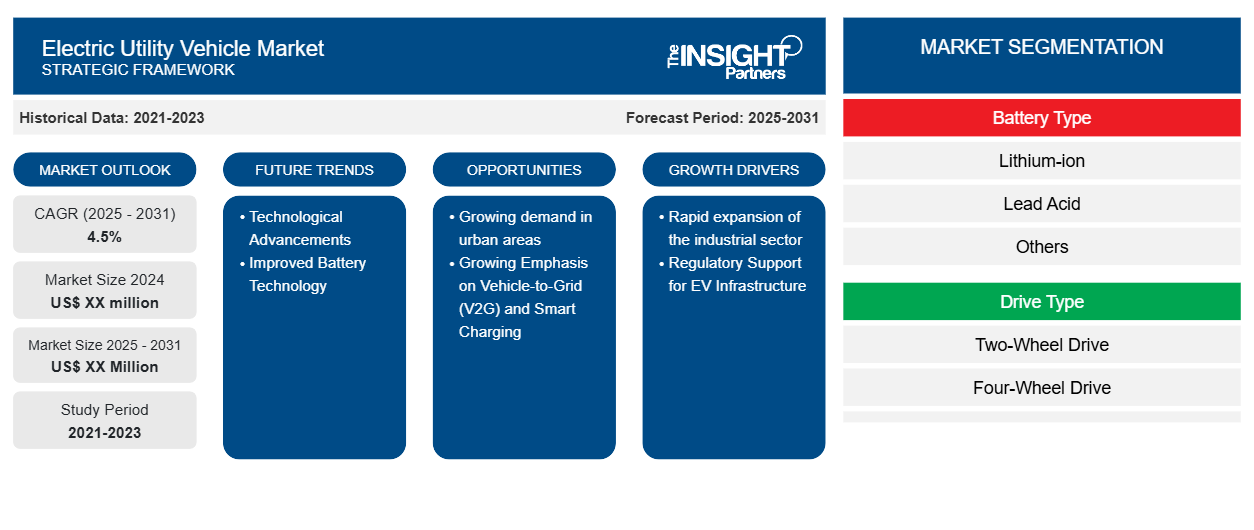من المتوقع أن يسجل سوق المركبات الكهربائية متعددة الاستخدامات معدل نمو سنوي مركب بنسبة 4.5٪ من عام 2023 إلى عام 2031، مع توسع حجم السوق من XX مليون دولار أمريكي في عام 2023 إلى XX مليون دولار أمريكي بحلول عام 2031.
يغطي سوق المركبات الكهربائية متعددة الاستخدامات التحليل حسب نوع البطارية (أيون الليثيوم، حمض الرصاص، وغيرها)؛ نوع القيادة (الدفع الثنائي، والدفع الرباعي)، حسب السرعة (حتى 25 ميلاً في الساعة، 26-45 ميلاً في الساعة، وفوق 45 ميلاً في الساعة)، التطبيق (التعدين، والبناء والتشييد، والرياضة، والزراعة، وملعب الجولف، والتجاري، وغيرها)،
غرض التقرير
يهدف تقرير سوق المركبات الكهربائية متعددة الاستخدامات الصادر عن The Insight Partners إلى وصف المشهد الحالي والنمو المستقبلي وأهم العوامل الدافعة والتحديات والفرص. وسيوفر هذا رؤى لمختلف أصحاب المصلحة في الأعمال التجارية، مثل:
- مزودي/مصنعي التكنولوجيا: لفهم ديناميكيات السوق المتطورة ومعرفة فرص النمو المحتملة، وتمكينهم من اتخاذ قرارات استراتيجية مستنيرة.
- المستثمرون: إجراء تحليل شامل للاتجاهات فيما يتعلق بمعدل نمو السوق، وتوقعات السوق المالية، والفرص المتاحة عبر سلسلة القيمة.
- الهيئات التنظيمية: لتنظيم السياسات ومراقبة الأنشطة في السوق بهدف تقليل الانتهاكات والحفاظ على ثقة المستثمرين ودعم سلامة السوق واستقرارها.
تجزئة سوق المركبات الكهربائية متعددة الاستخدامات
نوع البطارية
- ليثيوم أيون
- حمض الرصاص
- آحرون
نوع المحرك
- الدفع بالعجلتين
- الدفع الرباعي
سرعة
- تصل إلى 25 ميلا في الساعة
- 26-45 ميلا في الساعة
- فوق 45 ميلا في الساعة
طلب
- التعدين
- البناء والتشييد
- الرياضة
- زراعة
- ملعب الجولف
- تجاري
- آحرون
طلب
- التعدين
- البناء والتشييد
- الرياضة
- زراعة
- ملعب الجولف
- تجاري
- آحرون
قم بتخصيص هذا التقرير ليناسب متطلباتك
ستحصل على تخصيص لأي تقرير - مجانًا - بما في ذلك أجزاء من هذا التقرير، أو تحليل على مستوى الدولة، وحزمة بيانات Excel، بالإضافة إلى الاستفادة من العروض والخصومات الرائعة للشركات الناشئة والجامعات
-
احصل على أهم اتجاهات السوق الرئيسية لهذا التقرير.ستتضمن هذه العينة المجانية تحليلاً للبيانات، بدءًا من اتجاهات السوق وحتى التقديرات والتوقعات.
محركات نمو سوق المركبات الكهربائية متعددة الاستخدامات
- التوسع السريع للقطاع الصناعي: في جميع أنحاء العالم، يعد التوسع السريع للقطاع الصناعي عاملاً رئيسيًا في نمو السوق. إن التركيز المتزايد لشركات صناعة السيارات على المركبات الخالية من انبعاثات الكربون يدفع نمو السوق. وفقًا لمنظمة India Brand Equity Foundation Foundation، من المتوقع أن يصل قطاع التصنيع الصناعي في الهند إلى تريليون دولار أمريكي بحلول عام 2026. مع هذا النمو في التنمية الصناعية، ينمو الطلب على المركبات الكهربائية متعددة الاستخدامات بوتيرة سريعة.
- الدعم التنظيمي للبنية التحتية للسيارات الكهربائية: تستثمر الحكومات أيضًا في توسيع البنية التحتية لشحن السيارات الكهربائية لدعم تبني المركبات الكهربائية. تعمل هذه الاستثمارات على خفض حاجز الدخول أمام مشغلي الأساطيل والمستهلكين من خلال ضمان الوصول على نطاق واسع إلى حلول الشحن السريعة والفعالة.
اتجاهات مستقبل سوق المركبات الكهربائية متعددة الاستخدامات
- التطورات التكنولوجية: إن التطور المتزايد لنماذج المركبات الكهربائية القائمة على التكنولوجيا المتقدمة من قبل اللاعبين الرئيسيين يخلق فرصًا كبيرة في السوق. على سبيل المثال، في مارس 2023، أطلقت شركة Club Car، الشركة الرائدة عالميًا في تصنيع المركبات الكهربائية ذات العجلات الصغيرة عديمة الانبعاثات، أحدث مركباتها الكهربائية القانونية للطرق، وهي Club Car Urban LSV وXR المتوفرة الآن من خلال شبكة الموزعين التجاريين لدينا في أمريكا الشمالية. تعمل منصة Urban الجديدة على توسيع محفظة المركبات الكهربائية الرائدة لشركة Club Car، والتي كانت بارزة في الأسواق التجارية لعقود من الزمان. تتميز سيارة Club Car Urban الجديدة بتصميمها الأنيق وتصميمها المريح وسرعتها القصوى التي تبلغ 25 ميلاً في الساعة للاستخدام على الطرق والقدرة على تخصيص السيارة لاحتياجات محددة، وتوفر حلاً فريدًا للمركبة الخدمية يلبي احتياجات الحرم الجامعي الكبير والتوصيل إلى الميل الأخير والبلديات وأماكن الضيافة. (أخبار موقع الشركة)
- تحسين تكنولوجيا البطاريات: يعد التقدم السريع في تكنولوجيا بطاريات الليثيوم أيون أحد العوامل الرئيسية التي تمكن سوق المركبات الكهربائية متعددة الاستخدامات. أدت الابتكارات في كيمياء البطاريات إلى تحسينات في كثافة الطاقة وسرعة الشحن والفعالية من حيث التكلفة، مما يعزز بشكل مباشر أداء المركبات الكهربائية وقدرتها على تحمل التكاليف. ومع استمرار انخفاض أسعار البطاريات، أصبحت المركبات الكهربائية متعددة الاستخدامات أكثر قدرة على المنافسة مع نظيراتها من المركبات التي تعمل بالاحتراق الداخلي.
فرص سوق المركبات الكهربائية متعددة الاستخدامات
- الطلب المتزايد في المناطق الحضرية: من المتوقع أن يؤدي الطلب المتزايد من المناطق الحضرية على خدمات التوصيل، والطلب المتزايد على المركبات الخدمية لإدارة النفايات، والطلب المتزايد على وسائل النقل العام إلى خلق فرص كبيرة لنمو السوق. بالإضافة إلى ذلك، تُستخدم المركبات الخدمية الكهربائية على نطاق واسع من قبل الشركات البلدية والسلطات الرياضية وغيرها.
- التركيز المتزايد على أنظمة توصيل المركبات إلى الشبكة والشحن الذكي: مع تزايد تكامل المركبات الكهربائية مع تقنيات الشبكة الذكية، تتزايد فرص أنظمة توصيل المركبات إلى الشبكة وحلول الشحن الذكي. تسمح هذه التقنيات للمركبات الكهربائية ليس فقط بسحب الطاقة من الشبكة ولكن أيضًا بإعادة الطاقة خلال فترات الذروة، مما يوفر وفورات محتملة لمشغلي الأساطيل ويساهم في استقرار شبكة الطاقة.
رؤى إقليمية حول سوق المركبات الكهربائية متعددة الاستخدامات
لقد قام المحللون في Insight Partners بشرح الاتجاهات والعوامل الإقليمية المؤثرة على سوق المركبات الكهربائية متعددة الاستخدامات طوال فترة التوقعات بشكل شامل. يناقش هذا القسم أيضًا قطاعات سوق المركبات الكهربائية متعددة الاستخدامات والجغرافيا في جميع أنحاء أمريكا الشمالية وأوروبا ومنطقة آسيا والمحيط الهادئ والشرق الأوسط وأفريقيا وأمريكا الجنوبية والوسطى.

- احصل على البيانات الإقليمية المحددة لسوق المركبات الكهربائية متعددة الاستخدامات
نطاق تقرير سوق المركبات الكهربائية متعددة الاستخدامات
| سمة التقرير | تفاصيل |
|---|---|
| حجم السوق في عام 2023 | XX مليون دولار أمريكي |
| حجم السوق بحلول عام 2031 | XX مليون دولار أمريكي |
| معدل النمو السنوي المركب العالمي (2023 - 2031) | 4.5% |
| البيانات التاريخية | 2021-2022 |
| فترة التنبؤ | 2024-2031 |
| القطاعات المغطاة |
حسب نوع البطارية
|
| المناطق والدول المغطاة |
أمريكا الشمالية
|
| قادة السوق وملفات تعريف الشركات الرئيسية |
|
كثافة اللاعبين في سوق المركبات الكهربائية متعددة الاستخدامات: فهم تأثيرها على ديناميكيات الأعمال
يشهد سوق المركبات الكهربائية متعددة الاستخدامات نموًا سريعًا، مدفوعًا بالطلب المتزايد من المستخدم النهائي بسبب عوامل مثل تفضيلات المستهلكين المتطورة والتقدم التكنولوجي والوعي المتزايد بفوائد المنتج. ومع ارتفاع الطلب، تعمل الشركات على توسيع عروضها والابتكار لتلبية احتياجات المستهلكين والاستفادة من الاتجاهات الناشئة، مما يؤدي إلى زيادة نمو السوق.
تشير كثافة اللاعبين في السوق إلى توزيع الشركات أو المؤسسات العاملة في سوق أو صناعة معينة. وهي تشير إلى عدد المنافسين (اللاعبين في السوق) الموجودين في مساحة سوق معينة نسبة إلى حجمها أو قيمتها السوقية الإجمالية.
الشركات الرئيسية العاملة في سوق المركبات الكهربائية متعددة الاستخدامات هي:
- أمريكان لاند ماستر
- سيارات بينتيلي الكهربائية
- شركة ديري
- شركة إنجرسول راند المحدودة
- شركة مارشيل جرين باور المحدودة
إخلاء المسؤولية : الشركات المذكورة أعلاه ليست مرتبة بأي ترتيب معين.

- احصل على نظرة عامة على أهم اللاعبين الرئيسيين في سوق المركبات الكهربائية متعددة الاستخدامات
نقاط البيع الرئيسية
- التغطية الشاملة: يغطي التقرير بشكل شامل تحليل المنتجات والخدمات والأنواع والمستخدمين النهائيين لسوق المركبات الكهربائية متعددة الاستخدامات، مما يوفر صورة شاملة.
- تحليل الخبراء: تم تجميع التقرير على أساس الفهم العميق لخبراء الصناعة والمحللين.
- معلومات محدثة: يضمن التقرير أهمية الأعمال التجارية بسبب تغطيته للمعلومات الحديثة واتجاهات البيانات.
- خيارات التخصيص: يمكن تخصيص هذا التقرير لتلبية متطلبات العملاء المحددة وبما يتناسب مع استراتيجيات العمل بشكل مناسب.
وبالتالي، فإن تقرير البحث حول سوق المركبات الكهربائية متعددة الاستخدامات يمكن أن يساعد في تمهيد الطريق لفك شفرة وفهم سيناريو الصناعة وآفاق النمو. ورغم وجود بعض المخاوف المشروعة، فإن الفوائد الإجمالية لهذا التقرير تميل إلى التفوق على العيوب.
- التحليل التاريخي (سنتان)، سنة الأساس، التوقعات (7 سنوات) مع معدل النمو السنوي المركب
- تحليل PEST و SWOT
- حجم السوق والقيمة / الحجم - عالمي، إقليمي، بلد
- الصناعة والمنافسة
- مجموعة بيانات إكسل
التقارير الحديثة
تقارير ذات صلة
شهادات العملاء
سبب الشراء
- اتخاذ قرارات مدروسة
- فهم ديناميكيات السوق
- تحليل المنافسة
- رؤى العملاء
- توقعات السوق
- تخفيف المخاطر
- التخطيط الاستراتيجي
- مبررات الاستثمار
- تحديد الأسواق الناشئة
- تحسين استراتيجيات التسويق
- تعزيز الكفاءة التشغيلية
- مواكبة التوجهات التنظيمية























 احصل على عينة مجانية ل - سوق المركبات الكهربائية متعددة الاستخدامات
احصل على عينة مجانية ل - سوق المركبات الكهربائية متعددة الاستخدامات